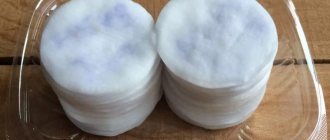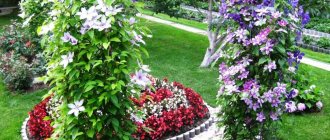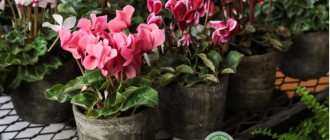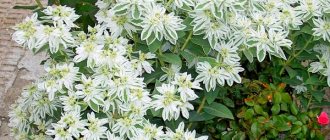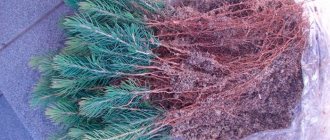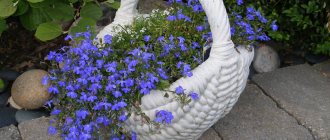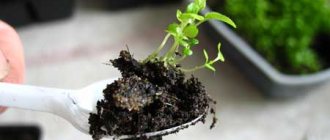Delphinium wins hearts at first sight. Hundreds of varieties and hybrids with different flowering periods, double and single flowers. And what a color palette! This is truly a universal plant for site design. And most importantly, it’s worth planting a bush once, and it will delight you with flowering for 15-17 years, gaining strength every year. Huge bouquets will become a real decoration. Tall and slender bushes look solemn, and at dusk, varieties with light petals look like candles.
Methods for growing delphinium
Delphinium, also known as larkspur, can be propagated by cuttings and seeds. But when harvesting them, there is a high risk of infection of the rhizome. Any chips and cuts can lead to root rot, so it is better to collect seeds from your favorite plant, if it is a hybrid variety or you decide to try growing something new, buy a couple of bags.
How to collect quality seeds
Delphinium seeds set surprisingly easily and, as a rule, up to 800 seeds can be collected from each plant with 4-5 inflorescences. But not all seeds will be of equal quality. In order to collect really good seeds, and the process itself does not lead to a deterioration in the development of the plant, or does not affect the quality of preparation for wintering, you need to prevent all the seeds in the inflorescence from ripening. Leave only 10-15 leaflets in the delphinium candles at the bottom of the inflorescences and do not let them spill onto the ground (delphinium self-sows abundantly, and the seeds germinate very quickly).
Collection of delphinium seeds
You can collect seeds from any healthy plant. If the variety is unknown to you, but you really like the flowers, try growing them. Hybrids produce good seeds, but the plant will not repeat itself. There is a splitting of signs. You will get two varieties at once; they may bear little resemblance to their ancestor. Varieties without the F1 designation can be safely propagated by seeds, although there is a risk of cross-pollination by insects if other varieties grow very close by.
After flowering, seed boxes appear on the bushes. At first they are green, a little later they turn brown. From now on you need to watch carefully. As soon as the boxes begin to dry, they need to be cut off and laid out on paper in a dry place. Do not collect seeds after watering, rain or heavy fog. Separate the seeds from the partitions and flaps. Dry them for a couple of days, then put them in a paper bag in the refrigerator. Do not leave on a shelf or in a closet. Germination rate drops very quickly in warm conditions.
Selection of planting material
It is very important that delphinium seeds are as fresh as possible. When purchasing in a store, pay attention to the release date indicated on the packaging. It is better not to buy planting material collected a year ago. Only seeds that ripen in the current season germinate well.
Those who decide to collect their own planting material must wait until autumn. When the capsule ripens, it becomes dry and turns brown. Seed collection must be carried out in dry weather. Store delphinium planting material in the refrigerator, first placing it in a paper envelope. Low temperature helps preserve germination.
Roses from seeds: suitable varieties and preparation of seed for planting
Sowing time
The optimal time for sowing delphinium seedlings is February. By the time of planting in open ground, the plants will be quite strong, many of them will be able to bloom in the first year. This crop is not at all afraid of frost, but there is no need to rush into planting. In warm conditions, seedlings develop faster.
Sowing in open ground can be done in the fall before winter and with the onset of the first warm days. However, this method is more suitable for unpretentious varieties and only if you have a lot of seeds. In a snowless winter or severe spring frosts, seeds or seedlings may die. But there is also a plus in this. If the plants have sprouted well enough, you can select only the strongest specimens. Those that can withstand adverse conditions will be best adapted to your climate.
Brief information about the culture
Delphinium has several common names, such as larkspur and spur. This plant of the buttercup family can grow in both warm and temperate climates. The culture has many types, among which there are both annual and perennial varieties. There are types of delphinium that reach 2 meters in height, but there are also decorative border varieties.
Delphinium is often used in folk medicine. It has an antiparasitic and hemostatic effect, treats headaches and toothaches, pneumonia, and cystitis.
Among the huge variety of varieties, New Zealand varieties can be distinguished. This species is considered expensive, there will be only a few seeds in the bag, and the plant will be large.
Ideal soil for delphinium
If it is not possible to purchase neutral soil for cacti or succulents, buy soil for seedlings. Delphinium does not tolerate acidic soil; preparing neutral, slightly acidic or slightly alkaline soil yourself is difficult, but quite possible. To do this, use a measuring container. Add one cup each of peat, turf soil, humus and half a cup of coarse sand. Mix everything until smooth. If the soil is too heavy, add chopped straw or perlite.
Correctly selected soil
Delphiniums like loose soil that allows air and moisture to pass through well. By choosing from ready-made substrates, you can take soil for planting succulent plants. If desired, it is easy to make your own soil mixture. For this you will need:
- 1 part of turf land;
- 1 part humus;
- 1 part peat;
- 0.5 parts sand.
For those who like to flood their plants, it is recommended to add perlite to the mixture. The granules will absorb moisture during excessive watering, and then gradually release it to the roots of the seedlings. In order to disinfect the soil, it is necessary to spill a solution of potassium permanganate or Fitosporin a day or two before planting. Store-bought soil does not need disinfection.
Stratification of delphinium seeds
Stratification significantly increases seed germination and makes seedlings healthier and more stress-resistant. Seeds should be sown in a shallow seedling box or in peat tablets, moisten the soil, close the container tightly, wrap it in plastic so that the moisture does not evaporate and put it in the refrigerator. Of course, a veranda or balcony is suitable, but there may be temperature changes there that can have a detrimental effect on germination. Seeds may die at temperatures below -5 degrees.
After 10-12 days you need to inspect the containers. The fact is that seeds can hatch even in the refrigerator. If you see shoots, it’s time to put them in a lighted place. A window sill where the temperature does not exceed +20 degrees is well suited.
When to plant seeds for seedlings
The timing of planting seeds depends on the climatic conditions of the region:
- in the southern regions, sowing is carried out in February; due to the warm climate, seedlings take root in the plots already in April;
- in the middle zone, seeds are sown in mid-March, planting in the ground is carried out in May;
- in colder northern regions - at the end of March, seedlings are planted outside in late May - early June, after noticeable warming (the likelihood of frost should be excluded).
Experienced gardeners also focus on favorable dates according to the Lunar calendar.
Caring for delphinium seedlings
Lighting is necessary even on a south window. In February, daylight hours are too short for delphinium. Water at the roots as needed; the soil on the surface should always be moist. Do not spray plants.
At the stage of two true leaves, seedlings must be picked. Plant those grown in peat tablets in containers. To ensure that the plants are well developed, 300 ml containers are sufficient. When planting, bury the young shoots down to the base of the leaf growth. In mid-to-late May, seedlings should be planted in a permanent place; a week before, feed them with Agricola or other soluble fertilizer. In order not to make a mistake with the dosage, the easiest way to do this is with a syringe. Be sure to combine fertilizing with watering to evenly distribute nutrients in the soil. Do not forget to sunbathe the plants, gradually increasing their duration, so that the delphiniums do not experience stress during transplantation.
Delphinium: types and varieties
The variety of forms of delphinium does not always allow us to set clear boundaries for identifying all varieties. According to one version, there are more than 1000 species of delphinium, according to another - no more than 450. Among them there are annuals and perennials.
Cultural delphinium, which unites all hybrids, is planted in gardens.
This is a perennial up to 1.8 m high with a spike-shaped inflorescence. Within a species, groups are distinguished that have external differences.
The most popular varieties of hybrids:
- Belladonna. The stem is up to 1.2 m high, the inflorescences are paniculate, the leaves are dissected, it blooms in early summer. Among the many varieties are: “Arnold Bekrir” (blue), “Casablanca” (snow-white with an apricot eye), “Lamartine” (dark blue, semi-double).
- Elatum. Tall varieties (1.5 - 1.8 m), dense, spike-shaped inflorescences, flowers with a large semi-double corolla.
- New Zealand hybrids. Flowers with double and semi-double corollas and short stems overwinter well without shelter.
- Marfin hybrids. Semi-double flowers of different colors, bred by a Russian breeder in the village of Marfino in the second half of the last century. They are highly decorative and winter hardy. Varieties: “Morpheus” – lilac, semi-double with a chocolate eye, “Blue Lace” – blue with a snow-white center.
- Pacific hybrids. The stems are tall (up to two meters) with large inflorescences, the flower corollas are semi-double. Varieties: “Dwarf Snow White” – semi-double white with a yellowish eye, “King Arthur” – purple-violet semi-double with a snow-white eye.
Delphinium grandiflora is also grown in gardens. In nature, this species is common in Eastern Siberia and the Far East.
Among annuals, the popular delphinium royal (sowing) or Ajax (garden). Interesting varieties of Ajax delphinium: “Double-Haycent-flowered” with buds of different colors and “Messenger White”, which bears white flowers.
Planting delphinium in open ground
Choose a place where nothing will disturb the plant in the coming years. Add organic fertilizer to more than just the holes. It is better to fertilize the entire bed to improve the structure and nutritional value of the soil. Handle the seedlings while preserving the earthen clod. At first, it is necessary to diffuse the sunlight. An agrofibre shelter is suitable for this. After 3-5 days the plants adapt; after lunch, remove the cover.
Already in August, most of the bushes will delight you with gorgeous candles of flowers, and a year later you can admire full bloom. Delphinium is one of the most magnificent perennials; be sure to place it on your site.
And for those who love flowers and are ready to learn all the intricacies of care and cultivation, in our “Floriculture” section you will always find the most up-to-date tips on growing flowers for both beginners and experienced gardeners, articles on garden decoration, sowing features, as well as many other very useful materials.
Author of the article: Oksana Artemenko
Recommendations and common mistakes
It is necessary to take into account the peculiarities of growing delphinium from seeds in order to obtain strong and healthy perennials. Experienced gardeners recommend:
- supplement the seedlings with a phytolamp when there is insufficient natural sunlight;
- plant the freshest seeds possible in the spring - grains older than a year develop much worse;
- maintain the room temperature no higher than 22 and no lower than 16 °C for successful cultivation;
- It is imperative to disinfect the soil and seedling container before sowing seeds.
If all the rules are followed, the delphinium will bloom at the end of August or September. With the onset of cold weather, it will need to be trimmed and covered with coniferous spruce branches or dry leaves.
Why do delphinium seeds not germinate?
Even experienced gardeners encounter difficulties when growing delphinium from seeds, since the germination rate of the crop is very low. The following factors may interfere with germination:
- lack of preliminary stratification;
- soil of unsuitable composition or contaminated with fungi;
- insufficient or excessive watering;
- lack of sunlight when growing seedlings;
Planting seeds too deeply in a common container has a negative impact. In this case, the sprouts cannot break through to the surface for a long time.
To grow delphinium, you need to sow it abundantly, since out of 30-50 grains only 3-5 can sprout
How to grow seedlings correctly
Spring sowing can begin in March. At home, planting in a greenhouse can begin in April. As soon as several full leaves appear on the seedlings, you can start picking. Planting is carried out in 3 by 3 boxes. It is recommended to disinfect the soil mixture before planting. Before sowing, the seeds must be stored under the right conditions: dry, at a temperature of 3-5 degrees Celsius (for example, a refrigerator).
The optimal container for sowing is a plastic container that has a lid; the depth should be 8-10 centimeters. The soil mixture can be prepared in several ways.
The substrate is sifted before adding to the container. Leave a centimeter to the top edge. Next, you need to compact the soil and water it with any disinfectant (Fundazol, Previkur, Maxim, Potassium permanganate).
There should be no more than 3 seeds per centimeter square.
Sowing goes through a period of stratification, the container with seeds is covered with film (plastic bag), and placed in a cool place (refrigerator).
Important! Seeds should not be soaked; they must be dry when sowing. Stratification is carried out in the refrigerator.
The stratification period lasts approximately 15 days, while the temperature is maintained at 3-5 degrees Celsius. During this period, no additional care is required. After half a month, the crops are removed from the refrigerator, the film is removed, and placed in a warm place (a well-lit windowsill). In this case, the temperature should be about 20 degrees. During this period, the first shoots can be observed.
Reproduction by dividing the bush
Propagation of delphinium by dividing the bush is a simple and common way to obtain healthy and strong shoots, which allows you to preserve the varietal characteristics of the mother plant as much as possible. Bushes that are 3-4 years old are best suited for division. Younger plants do not have enough strength to form full-fledged bushes, and older plants are often susceptible to disease and do not adapt well to another site.
For propagation, choose strong, tall, healthy bushes. They can be divided in autumn or spring.
In spring, division is carried out immediately after the growth of young stems and leaves begins. In autumn, delphinium is propagated after repeated flowering, at the seed ripening stage.
Disease Control
To prevent fungal diseases, periodically water the flower with a solution of phytosporin.
Powdery mildew and black spot of leaves are treated by spraying with a 1% solution of Bordeaux mixture.
Ring spot
Ring spot
The carriers of this disease are aphids. Control measures include killing aphids and removing diseased plants.
Growing season
During the growing season, delphinium needs liquid. Each plant “drinks” about 60 liters of water. Therefore, once a week you should pour at least two buckets of water under the bush. After watering, you need to let the soil dry a little, and then loosen it and remove any existing weeds. When inflorescences begin to form on a plant, it desperately needs water, especially if it is very hot outside at that time. At this point, areas without flowers may appear on the inflorescences.
This can only be avoided if there is abundant watering, as well as if fertilizing is carried out using potassium-phosphorus fertilizers: 20 grams of the substance must be diluted in one bucket of water and one liter poured under each bush.
a brief description of
Delphinium comes from the Ranunculaceae family, which has about 400-500 species. They can be either annual or perennial. On average, the plant reaches a length of 40 centimeters to 2 meters, it all depends on the variety. The color palette is quite rich, from deep blue to white. All types of delphinium, except terry, have so-called “eyes” that attract insects for pollination.
Delphinium prefers warm and bright areas, well protected from wind and drafts. It is in such conditions that growing flowers will be most favorable, and care will not be difficult. It is recommended to choose a place for planting such that the sun is hidden for several hours and a shadow is created.
The root system of many species is very branched and does not have a main root. Every year, the roots grow into young shoots, from which new flowers are born.
In southern latitudes, the plant can bloom several times a year, in early summer and autumn. In warm latitudes, the flowering period is longer - June-July, and also in autumn. The secondary plant will only bloom if the flower stalks are cut back after the initial bloom.
Flowers are very resistant to frost and can tolerate temperatures up to 40° below zero. Thaws pose a great danger to delphinium. The reason for this is the rhizome located on the surface of the soil. Therefore, you should not plant flowers in areas where clearings form in the spring.
Sowing work
After the seeds have been processed, the soil and containers have been prepared, you can begin sowing the seeds:
- the container is filled with soil and compacted to fill the voids;
- if planting is done in a common container, the seeds are sown at a distance of 1-2 cm from each other. If the container is individual, then 1-2 seeds.
- sprinkle with soil 2 mm thick on top.
- moisten the soil with a spray bottle;
- the container is covered with film or a lid;
- put in the refrigerator for 2 weeks for stratification.
The container with seedlings does not require ventilation, but when the soil dries out, regular moistening is required.
Watering delphinium seedlings
Delphiniums do not like waterlogged soil. Excess moisture can cause rotting of the rhizome, but even if this disease bypasses the plants, overwatering will cause large areas without flowers to appear in the inflorescences. Because of such “bald spots,” plants will lose their decorative properties.
IN THE PHOTO: Automatic drip watering of seedlings or young plants is perhaps the most convenient way to organize watering.
Watering delphiniums should be plentiful during drought and after each application of fertilizer. A mineral solution will only be beneficial if it saturates the soil to the roots. In other cases, watering should be regular and moderate, not too often and not superficially.
